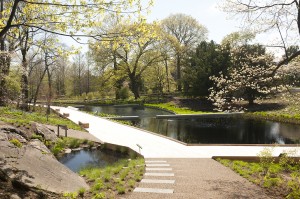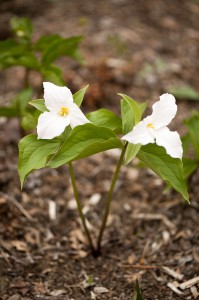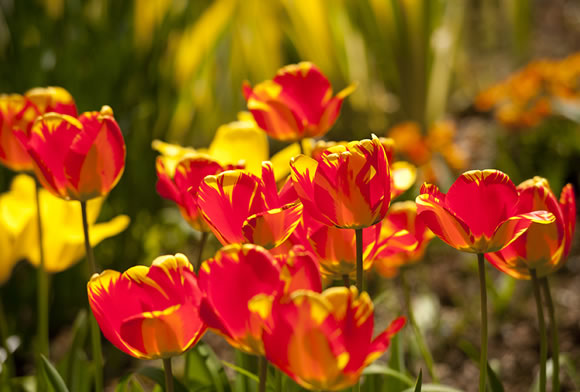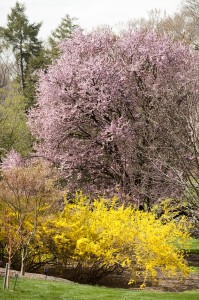Morning Eye Candy: Shooting Star
Posted in Photography on May 5 2013, by Ann Rafalko
Primula meadia ‘Goliath’ in the Native Plant Garden (photo by Ivo M. Vermeulen)

Inside The New York Botanical Garden
Posted in Photography on May 5 2013, by Ann Rafalko
Primula meadia ‘Goliath’ in the Native Plant Garden (photo by Ivo M. Vermeulen)
Posted in Photography on May 4 2013, by Ann Rafalko
It just doesn’t get any better than this! The new Native Plant Garden is open and the weather is perfect for celebrating. Join us!
Posted in Around the Garden on May 3 2013, by Ann Rafalko
 After many years and hundreds of thousand of plants, we’re opening our newest garden to the public, the Native Plant Garden! The Native Plant Garden is a spectacular, 3.5 acre showcase of the beautiful and diverse native plants of northeastern North America, and we’re celebrating all weekend with fun, festivities, music, wine, food, expert tours, workshops, family activities, and more.
After many years and hundreds of thousand of plants, we’re opening our newest garden to the public, the Native Plant Garden! The Native Plant Garden is a spectacular, 3.5 acre showcase of the beautiful and diverse native plants of northeastern North America, and we’re celebrating all weekend with fun, festivities, music, wine, food, expert tours, workshops, family activities, and more.
Tours will focus on the diversity of plants to be found in the garden and the birds that are already calling it home. Everyone is encouraged to borrow a palette and watercolors and let the Native Plant Garden inspire you or your children to create a masterpiece en plein air. Enjoy folk tunes and bluegrass from the very popular Milton. Shop for native plants and learn from the experts in a series of demos and author book signings.
There’s so much to do in the Native Plant Garden you might be inclined to just stay there and enjoy this beautiful new landscape, but you would be missing out on a wealth of other stunning vistas! Though there are only a few blooms, the Peggy Rockefeller Rose Garden is once again open for the season, and just above it you will find blooming tree peonies and fragrant stands of lilac. In the Ruth Rea Howell Family Garden, Mario Batali’s Kitchen Gardens have just been planted, and every child is encouraged to plant and play in the rest of the garden beds. In Cherry Valley a few tenacious blooms hold on, while tulips are everywhere in the Perennial Garden, Home Gardening Center, and along Seasonal Walk. In the Herb Garden you will be greeted by a “theater” of adorable and fascinating auricula primroses. The Azalea Garden is just beginning to glow in rosy hues of magenta, shocking pink, and seashell blush. Along Daffodil Hill the daffs are fading a bit, only to be outshone by gorgeous (and fragrant) crabapples. Basically, everywhere you turn there’s another stunning vista!
Posted in Photography on May 2 2013, by Ann Rafalko
The tree peonies are just beginning to bloom. They’re still feeling a little shy.
Posted in Gardening Tips on April 30 2013, by Sonia Uyterhoeven
 I was out in the woodland area of our soon-to-open Native Plant Garden and found myself overwhelmed by the beauty of all the different species of trillium we have planted there. Trilliums bloom in early spring, taking advantage of the time on the forest floor before the trees grow leaves and cast shade upon them. Trilliums, much as their name might suggest operate in threes: three leaves, three sepals, and three petals. The leaves are arranged in whorls wrapping around the stem from a single point. The result is a graceful zygomatic symmetry. Triullums are undoubtedly one of the most showy and elegant trichotomous woodland native plants.
I was out in the woodland area of our soon-to-open Native Plant Garden and found myself overwhelmed by the beauty of all the different species of trillium we have planted there. Trilliums bloom in early spring, taking advantage of the time on the forest floor before the trees grow leaves and cast shade upon them. Trilliums, much as their name might suggest operate in threes: three leaves, three sepals, and three petals. The leaves are arranged in whorls wrapping around the stem from a single point. The result is a graceful zygomatic symmetry. Triullums are undoubtedly one of the most showy and elegant trichotomous woodland native plants.
There are two types of trillium, sessile and pedunculate. The flowers of sessile trilliums rest on the leaves without a flower stalk while pedunculate trillium flowers are elevated by a stalk. Sessile trillium tend to have mottled leaves that are spotted with silver or maroon coloring while pedunculate trillium have green foliage. Trilliums are slow to grow on their knobby rhizomes, but will slowly spread and form a nice clump, though it may take up to seven years before they flower if you plant them from seed. But, the pay-off is that once a clump is established in your garden it will live for decades.
Posted in Photography on April 30 2013, by Ann Rafalko

Say that it is a crude effect, black reds,
Pink yellows, orange whites, too much as they are
To be anything else in the sunlight of the room,
Too much as they are to be changed by metaphor,
Too actual, things that in being real
Make any imaginings of them lesser things.
Bouquet of Roses In Sunlight ~ Wallace Stevens
Posted in Photography on April 27 2013, by Ann Rafalko
If Ferdinand the Bull were ever allowed into the Perennial Garden, I think he would make a beeline for this ‘Taurus’ rhododendron. He is a true flower connoisseur after all …
Photo by Ivo M. Vermeulen
Posted in Around the Garden on April 26 2013, by Ann Rafalko
This weekend brings a beautiful event to the Garden, the Garden Sculpture and Antiques Fair: 1750-2013! Vendors and artists from across the country and across the Atlantic are gathered together under the Conservatory Tent with a gorgeous range of functional and artistic decoration for your garden, patio, solarium, and home. In addition, enjoy complimentary wine tasting with the Naked Grape 12-5 p.m. each day as well as special tours and demonstrations.
Wares range from incredible contemporary kinetic sculpture, to tiny colonial lanterns, giant sprouting shallots, Majolica kittens, Grecian urns, mossy otters, and everything in between. The star of the show, however, seems to be a beautiful set of chairs featuring a peacock-motif that were once owned by the woman whose name graces our stately Conservatory, Enid A. Haupt. If your mother is a gardener with impeccable taste, the Garden Sculpture and Antiques Fair: 1750-2013 might just be the perfect place to pickup an unforgettable Mother’s Day present!
As if that weren’t enough, the Garden is just glorious right now. Cherry blossoms, daffodils, tulips, and a very special rhododendron are stopping people in their tracks across our 250-acres. There’s a palpable sense of happiness and ease wherever you go, with incredible scents wafting on the air, and smiles everywhere. And as if that weren’t enough, the lilacs seem set to pop at any moment! Just the thought of lilacs in this springtime sunshine makes me shoulders feel less tense.
Posted in Photography on April 25 2013, by Ann Rafalko
Follow us on Vine, @nybg
Posted in Gardening Tips on April 23 2013, by Sonia Uyterhoeven
 Forsythias have a bad reputation for good reason. They are ubiquitous and weedy and we bemoan them while simultaneously populating urban and suburban landscapes with them. Forsythia is far too easy and that is a recipe for horticultural disaster in terms of abuse and overuse. It’s a sad story for a shrub with potential but there it is.
Forsythias have a bad reputation for good reason. They are ubiquitous and weedy and we bemoan them while simultaneously populating urban and suburban landscapes with them. Forsythia is far too easy and that is a recipe for horticultural disaster in terms of abuse and overuse. It’s a sad story for a shrub with potential but there it is.
We all know forsythia with its dependable bright yellow flowers in spring. It’s an easy shrub to grow, tolerating a wide range of conditions and is free from pests and diseases. Forsythia flowers best in full sun but tolerates part shade, is fast growing and easy to propagate from cuttings.
Forsythia is indigenous to eastern Asia. While it is hard to distinguish different species–it seems like there is one generic mass market version –different species and varieties do exist.